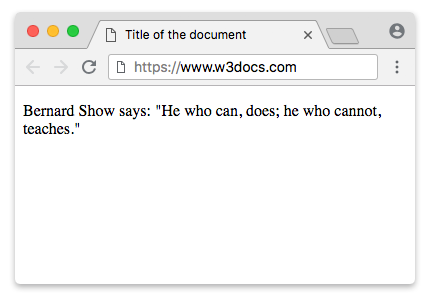The <q> tag is an inline element specifying short quotes, that don't span multiple lines. To insert longer quotes, you need to use the <blockquote> block-level element.
Besides defining quotes, the <q> tag is also used to define words or phrases, used in a figurative sense.
Browsers generally surround the text inside the <q> tag with quotation marks, the appearance of which depends on an HTML document encoding and the browser. You can change the appearance of quotation marks with the help of CSS styles.
Syntax
The <q> tag comes in pairs. The content is written between the opening (<q>) and closing (</q>) tags.
Example of the HTML <q> tag:
<!DOCTYPE html>
<html>
<head>
<title>Title of the document</title>
</head>
<body>
<p>Bernard Show says:
<q cite="https://www.wikiquote.org/">He who can, does; he who cannot, teaches.</q>
</p>
</body>
</html>Result

Example of the HTML <q> tag used with the <blockquote> tag:
<!DOCTYPE html>
<html>
<head>
<title>Title of the document</title>
</head>
<body>
<p>A quote from the Cheshire Cat, in the popular children's book, Alice In Wonderland, written by Lewis Carroll</p>
<blockquote cite="https://en.wikipedia.org/wiki/Alice%27s_Adventures_in_Wonderland">
I'm not crazy, my reality is just different than yours.
</blockquote>
<q cite="https://www.wikiquote.org/">He who can, does, he who cannot, teaches.</q>
</body>
</html>Attributes
| Attribute | Value | Description |
|---|---|---|
| cite | URL | Indicates the quote source. The user cannot see this information. |
The <q> tag supports the Global Attributes and the Event Attributes.
How to style <q> tag?
Common properties to alter the visual weight/emphasis/size of text in <q> tag:
- CSS font-style property sets the style of the font. normal | italic | oblique | initial | inherit.
- CSS font-family property specifies a prioritized list of one or more font family names and/or generic family names for the selected element.
- CSS font-size property sets the size of the font.
- CSS font-weight property defines whether the font should be bold or thick.
- CSS text-transform property controls text case and capitalization.
- CSS text-decoration property specifies the decoration added to text, and is a shorthand property for text-decoration-line, text-decoration-color, text-decoration-style.
Coloring text in <q> tag:
- CSS color property describes the color of the text content and text decorations.
- CSS background-color property sets the background color of an element.
Text layout styles for <q> tag:
- CSS text-indent property specifies the indentation of the first line in a text block.
- CSS text-overflow property specifies how overflowed content that is not displayed should be signalled to the user.
- CSS white-space property specifies how white-space inside an element is handled.
- CSS word-break property specifies where the lines should be broken.
Other properties worth looking at for <q> tag:
- CSS text-shadow property adds shadow to text.
- CSS text-align-last property sets the alignment of the last line of the text.
- CSS line-height property specifies the height of a line.
- CSS letter-spacing property defines the spaces between letters/characters in a text.
- CSS word-spacing property sets the spacing between words.
Browser support
|
|
|
|
|
|
|---|---|---|---|---|
| ✓ | ✓ | ✓ | ✓ | ✓ |
Practice Your Knowledge
Quiz Time: Test Your Skills!
Ready to challenge what you've learned? Dive into our interactive quizzes for a deeper understanding and a fun way to reinforce your knowledge.